Is sea level rise accelerating?
What the science says...
Looking at global data (rather than tide gauge records just from the U.S.) show that sea level rise has been increasing since 1880. The recent rate of sea level rise is greater than its average value since 1930. As for future sea level rise, these predictions are based on physics, not statistics.
Climate Myth...
Sea level rise is decelerating
"A former research director with the Army Corps of Engineers and a former civil-engineering professor at the University of Florida decided to put the sea-rise claims to the test. They gathered U.S. tide-gauge readings from 57 stations where water levels had been continuously recorded for as long as 156 years. The result did suggest the sea level was increasing in the western Pacific, but this was offset by a drop in the level near the Alaskan coast. “Our analyses do not indicate acceleration in sea level in U.S. tide gauge records during the 20th century,” the study’s authors concluded. “Instead, for each time period we consider, the records show small decelerations that are consistent with a number of earlier studies of worldwide-gauge records." (Washington Times)
A paper by Houston & Dean studies 57 tide gauge records from the U.S. (including Hawaii and oceanic territories) and concludes that sea level rise has not accelerated. In fact the authors seem to go out of their way to state that the average result shows deceleration at every opportunity. But there are some big questions about their analysis. Why do they use tide gauge records from just U.S. stations? Why not a global sample? Why use individual tide gauge records when we have perfectly good combinations, from much larger samples, which give a global picture of sea level change and show vastly less noise? Why do they restrict their analysis to either the time span of the individual tide gauge records, or to the period from 1930 to 2009? Why do they repeatedly drone on about “deceleration” when the average of the acceleration rates they measure, even for their extremely limited and restricted sample, isn’t statistically significant?
But the biggest question of all is: what’s the big deal?
Here’s some sea level data, in fact two data sets. One is a global combination of tide gauge records by Domingues et al. (2008). Using around 500 tide gauge records globally, it’s the latest version of the “Church & White” dataset. The other is satellite data:
I averaged the two data sources during their period of overlap, and computed a smoothed version:
This is a global data set, and it’s a worldwide average so its shows vastly less noise than individual tide gauge records. We could even use it to look for acceleration or deceleration in sea level rise. But one thing we should not do is restrict consideration to the quadratic term of a quadratic polynomial fit from 1930 onward. That would be pretty ignorant — maybe even misleading.
As so often happens, one thing to be cautious of is that the noise shows autocorrelation. As Houston & Dean point out, the Church & White data since 1930 are approximately linear, so to get a conservative estimate of the autocorrelation I used the residuals from a linear fit to just the post-1930 data and fit an ARMA(1,1) model.
If we compute the linear trend rate for all possible starting years from 1880 to 1990, up to the present, we get this:
According to this, the recent rate of sea level rise is greater than its average value since 1930. Significantly so (in the statistical sense), even using a conservative estimate of autocorrelation. But the increase itself hasn’t been steady, so the sea level curve hasn’t followed a parabola, most of the increase has been since about 1980. How could Houston & Dean have missed this?
Here’s how: first, they determined the presence or absence of acceleration or deceleration based only on the quadratic term of a quadratic fit. That utterly misses the point. Changes in the rate of sea level rise don’t have to follow a parabola, since 1930 or any time point you care to name. In fact, by all observations and predictions, they have not done so and will not do so.
Second, by using individual tide gauge records, the noise level is so high that you can’t really hope to find acceleration or deceleration of any kind, with any consistency. Not using quadratic fits, and certainly the non-parabolic trend which is present can’t be found in such noisy data sets.
Even so, we can also fit a quadratic (as Houston & Dean did), and estimate the acceleration (which is twice the quadratic coefficient):
Well well … it looks like starting at 1930 is the way to get the minimum “acceleration” by this analysis method. Could that be why Houston & Dean chose 1930 as their starting point?
If we restrict to only the data since 1930, as Houston & Dean did, and fit a quadratic trend, we get this:
Can you tell, just by looking, whether it curves upward or downward? Clearly, the parabolic fit doesn’t show much acceleration or deceleration, if any. We can get a better picture by first subtracting a linear fit, then fitting a parabola to the residuals?
That answers the question: the quadratic fit shows acceleration in the Church & White data. But, when autocorrelation is taken into account, the “acceleration” is not statistically signficant.
But — just because the data don’t follow a parabola, doesn’t mean that sea level hasn’t accelerated. Let’s take those residuals from a linear model, and fit a cubic polynomial instead:
Well well … there seems to be change after all, with both acceleration and deceleration but most recently, acceleration. And by the way, this fit is significant.
And now to the really important part, which is not the math but the physics. Whether sea level showed 20th-century acceleration or not, it’s the century coming up which is of concern. And during this century, we expect acceleration of sea level rise because of physics. Not only will there likely be nonlinear response to thermal expansion of the oceans, when the ice sheets become major contributors to sea level rise, they will dominate the equation. Their impact could be tremendous, it could be sudden, and it could be horrible.
The relatively modest acceleration in sea level so far is not a cause for great concern, but neither is it cause for comfort. The fact is that statistics simply doesn’t enable us to foresee the future beyond a very brief window of time. Even given the observed acceleration, the forecasts we should attend to are not from statistics but from physics.
Many thanks to Tamino from Open Mind for allowing us to republish his post So What?
Advanced rebuttal written by Tamino
Update July 2015:
Here is a related lecture-video from Denial101x - Making Sense of Climate Science Denial
This rebuttal was updated by Judith Matz on September 13, 2021 to replace broken links. The updates are a result of our call for help published in May 2021.
Last updated on 8 July 2015 by pattimer. View Archives































 Arguments
Arguments























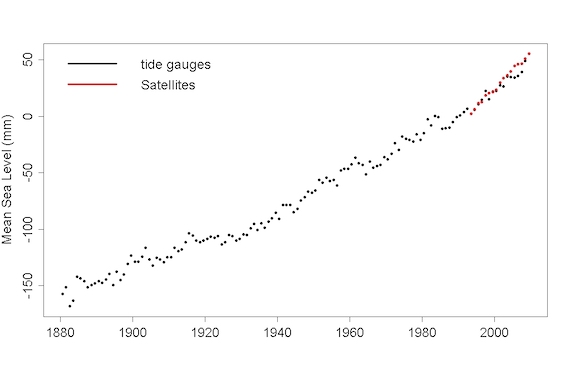
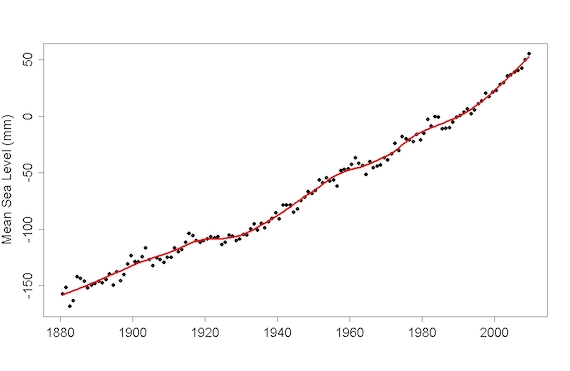
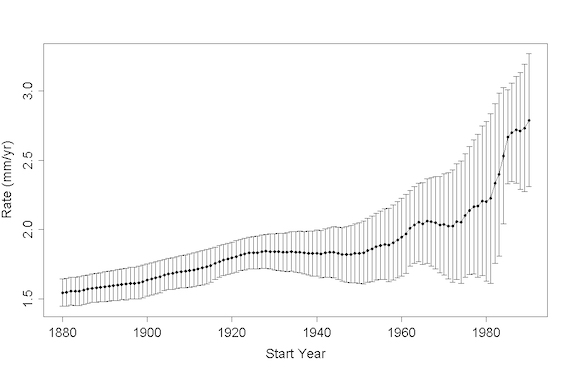
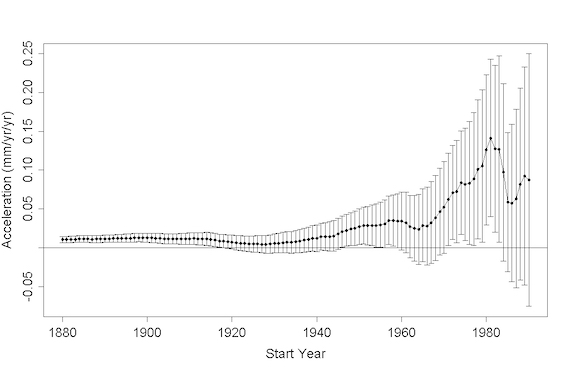
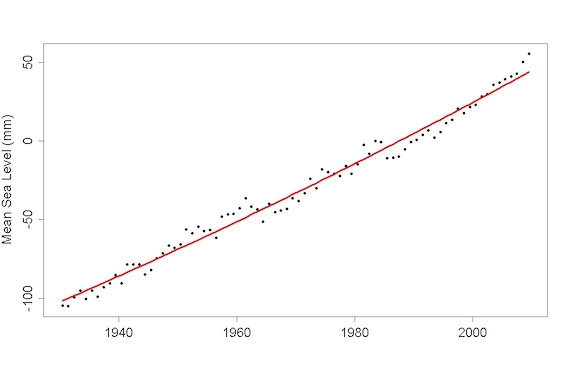
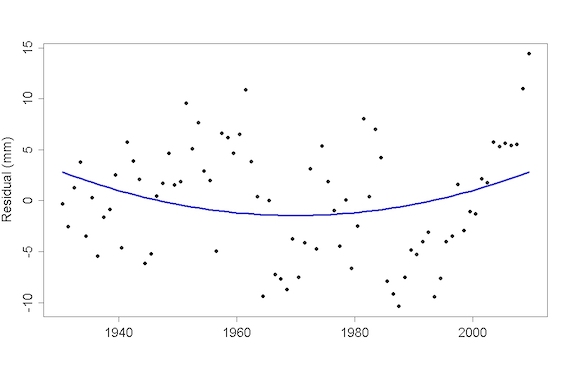
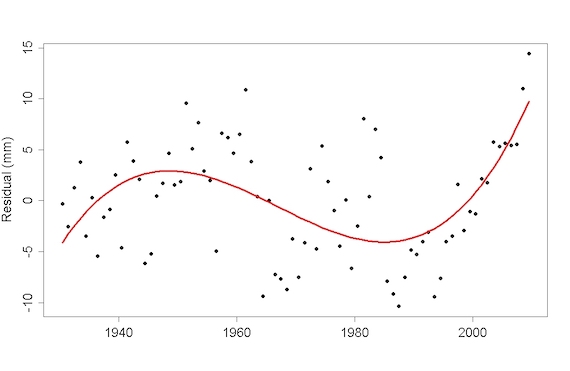







[DB] From Church & White 2011:
And using 16-years trends:
[Source]
[DB] In your desire to prosecute your agenda, you continue to cherry-pick by only using a small portion of the data available.
That is muoncounter & Tom Curtis' point, and the entire point of this post you are commenting on.
If you want to be taken seriously, you will have to rectify that & address the totality of the data, as Tamino did.
[DB] Speculations into motive snipped. Either formulate a comment that doesn't cast aspersions into other's integrity or don't post here.
Future comments containing such speculations and aspersion will be deleted outright.
[DB] In your ongoing desire to prosecute your agenda, you continue to cherry-pick by focusing on a small, statistically insignificant, portion of the data available.
Station ID 1234 Station Name SIROS Data available 1969 - 2009 Data used 1974.042 - 2009.958 Data not used 1969; 1971; 1972 Change in slope +1.8 mm/yr.
Maybe some one who has plunked down the cash for Church et al. (2004) can summarize what the editing criteria is.
[DB] If you were perchance to take the attitude of genuinely trying to research this instead of ascribing untowards motives to those publishing research and if you perchance were to genuinely ask for help when stuck instead of just airing complaints about paywalls, then perhaps someone might help you.
Like pointing out that Church et al 2004 was available for free opus download from the publisher, Journal of Climate:
http://journals.ametsoc.org/doi/pdf/10.1175/1520-0442%282004%29017%3C2609%3AEOTRDO%3E2.0.CO%3B2
Or that the data for Church et al 2004 appears to be available for free opus download at:
ftp://ftp.marine.csiro.au/pub/white/recons_1950_2001_ib_gia_remseas.nc.gz
Briefly, this data set is
on a 1° × 1° × 1 month grid
I'm certain you have been doing the above per established standards in your analysis.
Total time to research this: 6 minutes
Total time to write this up: 7 minutes
[DB] You're welcome; anytime.
[DB] "The satellite record date happened to start in 1993. That's the way it is. That you want to complain about it is isn't anything I can do much about."
You continue to cherry-pick by only using a small portion of the data available. Satellites only represent a portion of the data available to us. The consiliance of these datasets paints a different picture:
Your laser-focus on the most recent period of data while ignoring that which came before it blinds you to the larger trend while magnifying the natural variability inherent in the system.
In a nutshell, you can't see the forest because you have a tree in the way. That's the way it is.
[DB] Fixed tags.
The most likely reason for your lines diverging is that you are doing something wrong. I suggest you contact Dr. Church or Dr. White (or Tamino, as this is his post) for advice.
That would be the skeptical thing to do.